Hydrodynamics and Sediment-Transport Pathways along a Mixed-Energy Spit-Inlet System: A Modeling Study at Chincoteague Inlet (Virginia, USA)
Abstract
1. Introduction
Study Area
2. Materials and Methods
2.1. Data
Field Data Collection and Processing
2.2. Methodology
2.3. Model Implementation
2.3.1. Set-Up
Tides and Storm Surge
Winds and Waves
Sediment
2.3.2. Calibration and Validation: Skill Assessment
Hydrodynamics
Sediment Transport and Morphology
3. Results
3.1. Tidal and Subtidal Water and Sediment Exchange
3.2. Coastal Sediment Budgets
3.3. Spatial Patterns of Sediment Transport
4. Summary and Discussion
Supplementary Materials
Author Contributions
Funding
Institutional Review Board Statement
Informed Consent Statement
Data Availability Statement
Acknowledgments
Conflicts of Interest
References
- Davis, R.A.; FitzGerald, D.M. Beaches and Coasts, 2nd ed.; John Wiley & Sons: Hoboken, NJ, USA, 2020; ISBN 978-1-119-33451-4. [Google Scholar]
- McBride, R.A.; Anderson, J.B.; Buynevich, I.V.; Byrnes, M.R.; Cleary, W.; Fenster, M.S.; FitzGerald, D.M.; Hapke, C.J.; Harris, M.S.; Hein, C.J.; et al. Morphodynamics of Modern and Ancient Barrier Systems: An Updated and Expanded Synthesis. Earth Syst. Environ. Sci. 2022, 10, 289–417. [Google Scholar] [CrossRef]
- Hayes, M. Barrier Island Morphology as a Function of Tidal and Wave Regime. In Barrier Islands: From the Gulf of St. Lawrence to the Gulf of Mexico; Academic Press: London, UK, 1979; pp. 1–27. [Google Scholar]
- Herrling, G.; Winter, C. Tidal Inlet Sediment Bypassing at Mixed-Energy Barrier Islands. Coast. Eng. 2018, 140, 342–354. [Google Scholar] [CrossRef]
- FitzGerald, D.M. Shoreline Erosional-Depositional Processes Associated with Tidal Inlets. Lect. Notes Coast. Estuar. Stud. 1988, 29, 186–225. [Google Scholar]
- de Swart, H.E.; Zimmerman, J.T.F. Morphodynamics of Tidal Inlet Systems. Annu. Rev. Fluid Mech. 2009, 41, 203–229. [Google Scholar] [CrossRef]
- Fenster, M.; Dolan, R. Assessing the Impact of Tidal Inlets on Adjacent Barrier Island Shorelines. J. Coast. Res. 1996, 12, 294–310. [Google Scholar]
- FitzGerald, D.M.; Buynevich, I.; Hein, C. Morphodynamics and Facies Architecture of Tidal Inlets and Tidal Deltas. In Principles of Tidal Sedimentology; Springer Netherlands: Dordrecht, The Netherlands, 2010; pp. 301–333. ISBN 978-94-007-0123-6. [Google Scholar]
- Oertel, G.f. Processes of Sediment Exchange between Tidal Inlets, Ebb Deltas and Barrier Islands. In Hydrodynamics and Sediment Dynamics of Tidal Inlets; American Geophysical Union (AGU): Washington, DC, USA, 1988; pp. 297–318. ISBN 978-1-118-66924-2. [Google Scholar]
- Wang, Z.B.; Hoekstra, P.; Burchard, H.; Ridderinkhof, H.; De Swart, H.E.; Stive, M.J.F. Morphodynamics of the Wadden Sea and Its Barrier Island System. Ocean Coast. Manag. 2012, 68, 39–57. [Google Scholar] [CrossRef]
- Kraus, N.C.; Mark, D.J.; Sarruff, M.S. DMS: Diagnostic Modeling System. Report 1, Reduction of Sediment Shoaling by Relocation of the Gulf Intracoastal Waterway, Matagorda Bay, Texas. In This Digital Resource Was Created from Scans of the Print Resource; Coastal and Hydraulics Laboratory (U.S.) Engineer Research and Development Center (U.S.): Vicksburg, MS, USA, 2000. [Google Scholar]
- de Vriend, H.J.; Bakker, W.T.; Bilse, D.P. A Morphological Behaviour Model for the Outer Delta of Mixed-Energy Tidal Inlets. Coast. Eng. 1994, 23, 305–327. [Google Scholar] [CrossRef]
- Nienhuis, J.H.; Ashton, A.D. Mechanics and Rates of Tidal Inlet Migration: Modeling and Application to Natural Examples. J. Geophys. Res. Earth Surf. 2016, 121, 2118–2139. [Google Scholar] [CrossRef]
- Nienhuis, J.H.; Lorenzo-Trueba, J. Simulating Barrier Island Response to Sea Level Rise with the Barrier Island and Inlet Environment (BRIE) Model v1.0. Geosci. Model Dev. 2019, 12, 4013–4030. [Google Scholar] [CrossRef]
- Lesser, G.R.; Roelvink, J.A.; van Kester, J.A.T.M.; Stelling, G.S. Development and Validation of a Three-Dimensional Morphological Model. Coast. Eng. 2004, 51, 883–915. [Google Scholar] [CrossRef]
- Dodet, G.; Bertin, X.; Bruneau, N.; Fortunato, A.B.; Nahon, A.; Roland, A. Wave-Current Interactions in a Wave-Dominated Tidal Inlet. J. Geophys. Res. Ocean. 2013, 118, 1587–1605. [Google Scholar] [CrossRef]
- Elias, E.P.L.; Cleveringa, J.; Buijsman, M.C.; Roelvink, J.A.; Stive, M.J.F. Field and Model Data Analysis of Sand Transport Patterns in Texel Tidal Inlet (the Netherlands). Coast. Eng. 2006, 53, 505–529. [Google Scholar] [CrossRef]
- Herrling, G.; Winter, C. Morphological and Sedimentological Response of a Mixed-Energy Barrier Island Tidal Inlet to Storm and Fair-Weather Conditions. Earth Surf. Dynam. 2014, 2, 363–382. [Google Scholar] [CrossRef]
- Roelvink, J.A.; Dastgheib, A. Long-Term Process-Based Morphological Modeling of Large Tidal Basins; CRC Press/Balkema: Boca Raton, FL, USA, 2012. [Google Scholar]
- Nahon, A.; Bertin, X.; Fortunato, A.B.; Oliveira, A. Process-Based 2DH Morphodynamic Modeling of Tidal Inlets: A Comparison with Empirical Classifications and Theories. Mar. Geol. 2012, 291–294, 1–11. [Google Scholar] [CrossRef]
- Ridderinkhof, W.; de Swart, H.E.; van der Vegt, M.; Hoekstra, P. Modeling the Growth and Migration of Sandy Shoals on Ebb-Tidal Deltas. J. Geophys. Res. Earth Surf. 2016, 121, 1351–1372. [Google Scholar] [CrossRef]
- Tung, T.T.; Walstra, D.; de Graaff, J.V.; Stive, M.J.F. Morphological Modeling of Tidal Inlet Migration and Closure. Available online: https://www.jstor.org/stable/25737953 (accessed on 21 August 2022).
- Shawler, J.L.; Hein, C.J.; Obara, C.A.; Robbins, M.G.; Huot, S.; Fenster, M.S. The Effect of Coastal Landform Development on Decadal-to Millennial-Scale Longshore Sediment Fluxes: Evidence from the Holocene Evolution of the Central Mid-Atlantic Coast, USA. Quat. Sci. Rev. 2021, 267, 107096. [Google Scholar] [CrossRef]
- Fenster, M.S.; McBride, R.A. Barrier-Island Geology and Morphodynamics along the Open-Ocean Coast of the Delmarva Peninsula: An Overview. In Tripping from the Fall Line: Field Excursions for the GSA Annual Meeting, Baltimore; Geological Society of America: Boulder, CO, USA, 2015; Volume 40, pp. 310–334. [Google Scholar]
- Krantz, D.; Hobbs, C.; Wikel, G. Atlantic Coast and Inner Shelf. In The Geology of Virginia; William & Mary: Williamsburg, VA, USA, 2016. [Google Scholar]
- Sakib, M.M.; Georgiou, I.; Hein, C.; Fenster, M.; Zou, S.; Esposito, C.; Foster-Martinez, M.; Messina, F.; Trembanis, A. Mechanisms and Rates of Sand Bypassing along a Rapidly Evolving Inlet-Spit System. In Proceedings of the AGU Fall Meeting 2021, New Orleans, LA, USA, 13–17 December 2021. [Google Scholar]
- McPherran, K.A.; Dohner, S.M.; Trembanis, A.C. A Comparison of the Temporal Evolution of Hydrodynamics and Inlet Morphology during Tropical Storm Fay (2020). Shore Beach 2021, 89, 11–22. [Google Scholar] [CrossRef]
- Nowacki, D.J.; Ganju, N.K. Storm Impacts on Hydrodynamics and Suspended-Sediment Fluxes in a Microtidal Back-Barrier Estuary. Mar. Geol. 2018, 404, 1–14. [Google Scholar] [CrossRef]
- McBride, R.A.; Fenster, M.S.; Seminack, C.T.; Richardson, T.M.; Sepanik, J.M.; Hanley, J.T.; Bundick, J.A.; Tedder, E. Holocene Barrier-Island Geology and Morphodynamics of the Maryland and Virginia Open-Ocean Coasts: Fenwick, Assateague, Chincoteague, Wallops, Cedar, and Parramore Islands. In Tripping from the Fall Line: Field Excursions for the GSA Annual Meeting, Baltimore, 2015; Geological Society of America: Boulder, CO, USA, 2015. [Google Scholar] [CrossRef]
- Carruthers, T.; Beckert, K.; Dennison, B.; Thomas, J.; Saxby, T.; Williams, M. Assateague Island National Seashore Natural Resource Condition Assessment: Maryland, Virginia; Natural Resource Report NPS/ASIS/NRR—2011/405; National Park Service: Fort Collins, CO, USA, 2011. [Google Scholar]
- Kang, X.; Xia, M.; Pitula, J.S.; Chigbu, P. Dynamics of Water and Salt Exchange at Maryland Coastal Bays. Estuar. Coast. Shelf Sci. 2017, 189, 1–16. [Google Scholar] [CrossRef]
- Kang, X.; Xia, M. The Study of the Hurricane-Induced Storm Surge and Bay-Ocean Exchange Using a Nesting Model. Estuaries Coasts 2020, 43, 1610–1624. [Google Scholar] [CrossRef]
- Casey, J.; Wesche, A. Marine Benthic Survey of Maryland’s Coastal Bays: Part I, Spring and Summer Periods; Maryland Department of Natural Resources: Annapolis, MD, USA, 1981. [Google Scholar]
- Goodrich, D.M. On Meteorologically Induced Flushing in Three U.S. East Coast Estuaries. Estuar. Coast. Shelf Sci. 1988, 26, 111–121. [Google Scholar] [CrossRef]
- Cooperative Institute for Research in Environmental Sciences. Continuously Updated Digital Elevation Model (CUDEM)—1/9 Arc-Second Resolution Bathymetric-Topographic Tiles; Cooperative Institute for Research in Environmental Sciences: Boulder, CO, USA, 2014. [Google Scholar]
- Hiller, R.; Calder, B.; Hogarth, P.; Gee, L. Adapting CUBE for Phase Measuring Bathymetric Sonars; University of New Hampshire: Durham, NH, USA, 2005. [Google Scholar]
- Buczkowski, B.; Reid, J.A.; Schweitzer, P.N.; Cross, V.A.; Jenkins, C.J. UsSEABED: Offshore Surficial-Sediment Database for Samples Collected within the United States Exclusive Economic Zone; USGS: Reston, VA, USA, 2020. [Google Scholar] [CrossRef]
- Fenster, M.S.; Dolan, R.; Smith, J.J. Grain-Size Distributions and Coastal Morphodynamics along the Southern Maryland and Virginia Barrier Islands. Sedimentology 2016, 63, 809–823. [Google Scholar] [CrossRef]
- Folk, R.L. A Review of Grain-Size Parameters. Sedimentology 1966, 6, 73–93. [Google Scholar] [CrossRef]
- Deltares. Delft3D-FLOW: Simulation of Multidimensional Hydrodynamic Flows and Transport Phenomena, Including Sediments; Deltares: Delft, The Netherlands, 2014. [Google Scholar]
- Liu, K.; Chen, Q.; Hu, K.; Xu, K.; Twilley, R.R. Modeling Hurricane-Induced Wetland-Bay and Bay-Shelf Sediment Fluxes. Coast. Eng. 2018, 135, 77–90. [Google Scholar] [CrossRef]
- Sakib, M.; Nihal, F.; Haque, A.; Rahman, M.; Ali, M. Sundarban as a Buffer against Storm Surge Flooding. World J. Eng. Technol. 2015, 3, 59–64. [Google Scholar] [CrossRef]
- Salehi, M. Storm Surge and Wave Impact of Low-Probability Hurricanes on the Lower Delaware Bay—Calibration and Application. J. Mar. Sci. Eng. 2018, 6, 54. [Google Scholar] [CrossRef]
- Caldwell, R.L.; Edmonds, D.A. The Effects of Sediment Properties on Deltaic Processes and Morphologies: A Numerical Modeling Study. J. Geophys. Res. Earth Surf. 2014, 119, 961–982. [Google Scholar] [CrossRef]
- Hanegan, K.; Georgiou, I. Tidal Modulated Flow and Sediment Flux through Wax Lake Delta Distributary Channels: Implications for Delta Development. Proc. Int. Assoc. Hydrol. Sci. 2015, 367, 391–398. [Google Scholar] [CrossRef]
- Sakib, M.; Nihal, F.; Akter, R.; Maruf, M.; Akter, M.; Noor, S.; Rimi, R.A.; Haque, A.; Rahman, M. Afforestation as a Buffer against Storm Surge Flooding along the Bangladesh Coast. In Proceedings of the 12th International Conference on Hydroscience & Engineering, Tainan, Taiwan, 6–10 November 2016; p. 5. [Google Scholar]
- Sullivan, J.C.; Torres, R.; Garrett, A.; Blanton, J.; Alexander, C.; Robinson, M.; Moore, T.; Amft, J.; Hayes, D. Complexity in Salt Marsh Circulation for a Semienclosed Basin. J. Geophys. Res. Earth Surf. 2015, 120, 1973–1989. [Google Scholar] [CrossRef]
- Booij, N.; Ris, R.C.; Holthuijsen, L.H. A Third-Generation Wave Model for Coastal Regions 1. Model Description and Validation. J. Geophys. Res. Ocean. 1999, 104, 7649–7666. [Google Scholar] [CrossRef]
- Hajek, E.A.; Wolinsky, M.A. Simplified Process Modeling of River Avulsion and Alluvial Architecture: Connecting Models and Field Data. Sediment. Geol. 2012, 257–260, 1–30. [Google Scholar] [CrossRef]
- Leonardi, N.; Canestrelli, A.; Sun, T.; Fagherazzi, S. Effect of Tides on Mouth Bar Morphology and Hydrodynamics: Effect of Tides on Mouth Bar. J. Geophys. Res. Ocean. 2013, 118, 4169–4183. [Google Scholar] [CrossRef]
- Marciano, R.; Wang, Z.B.; Hibma, A.; de Vriend, H.J.; Defina, A. Modeling of Channel Patterns in Short Tidal Basins. J. Geophys. Res. Earth Surf. 2005, 110, F01001. [Google Scholar] [CrossRef]
- Nardin, W.; Mariotti, G.; Edmonds, D.A.; Guercio, R.; Fagherazzi, S. Growth of River Mouth Bars in Sheltered Bays in the Presence of Frontal Waves. J. Geophys. Res. Earth Surf. 2013, 118, 872–886. [Google Scholar] [CrossRef]
- van Rijn, L.C. Principles of Sediment Transport in Rivers, Estuaries and Coastal Seas; Aqua Publications: Amsterdam, The Netherlands, 1993. [Google Scholar]
- Partheniades, E. Erosion and Deposition of Cohesive Soils. J. Hydraul. Div. 1965, 91, 105–139. [Google Scholar] [CrossRef]
- Dietrich, J.C.; Westerink, J.J.; Kennedy, A.B.; Smith, J.M.; Jensen, R.E.; Zijlema, M.; Holthuijsen, L.H.; Dawson, C.; Luettich, R.A.; Powell, M.D.; et al. Hurricane Gustav (2008) Waves and Storm Surge: Hindcast, Synoptic Analysis, and Validation in Southern Louisiana. Mon. Weather Rev. 2011, 139, 2488–2522. [Google Scholar] [CrossRef]
- National Land Cover Database (NLCD), Ag Data Commons. Available online: https://data.nal.usda.gov/dataset/national-land-cover-database-2011-nlcd-2011 (accessed on 15 August 2022).
- Coon, W.F. Estimates of Roughness Coefficients for Selected Natural Stream Channels with Vegetated Banks in New York; U.S. Geological Survey; Earth Science Information Center, Open-File Reports Section [Distributor]; USGS: Ithaca, NY, USA, 1995. [Google Scholar]
- Nowacki, D.J.; Beudin, A.; Ganju, N.K. Spectral Wave Dissipation by Submerged Aquatic Vegetation in a Back-Barrier Estuary: Wave Dissipation by Vegetation. Limnol. Oceanogr. 2017, 62, 736–753. [Google Scholar] [CrossRef]
- Legates, D.R.; McCabe, G.J., Jr. Evaluating the Use of “Goodness-of-Fit” Measures in Hydrologic and Hydroclimatic Model Validation. Water Resour. Res. 1999, 35, 233–241. [Google Scholar] [CrossRef]
- Finkelstein, K. Cape Formation as a Cause of Erosion on Adjacent Shorelines. In Proceedings of the Coastal Zone’83; American Society of Civil Engineers: New York, NY, USA, 1983; pp. 620–640. [Google Scholar]
- Fritzen, R.; Lang, V.; Gensini, V.A. Trends and Variability of North American Cool-Season Extratropical Cyclones: 1979–2019. J. Appl. Meteorol. Climatol. 2021, 60, 1319–1331. [Google Scholar] [CrossRef]
- Wilcock, P.R. Toward a Practical Method for Estimating Sediment-Transport Rates in Gravel-Bed Rivers. Earth Surf. Process. Landf. 2001, 26, 1395–1408. [Google Scholar] [CrossRef]
- Fenster, M.S.; Bundick, J.A. Morphodynamics of Wallops Island, Virginia: A Mixed-Energy, Human-Modified Barrier Island. In Tripping from the Fall Line: Field Excursions for the GSA Annual Meeting, Baltimore, 2015: Geological Society of America Field Guide 40; Geological Society of America: Boulder, CO, USA, 2015; Volume 40, pp. 358–370. [Google Scholar]
- King, D.B., Jr.; Ward, D.L.; Hudgins, M.H.; Williams, G.G. Storm Damage Reduction Project Design for Wallops Island, Virginia. In Version 1.01: Engineer Research and Development Center, Vicksburg, MS, Coastal and Hydraulics Lab, Report No. ERDC/LAB TR-11-9; United States Army Corps of Engineers: Norfolk, VA, USA, 2010; p. 197. [Google Scholar]
- Moffatt, N. Wallops Island Shore Protection Study; NASA/Goddard Space Flight Facility: Wallops Island, VA, USA, 1986; p. 86. [Google Scholar]
- Robbins, M.G.; Shawler, J.L.; Hein, C.J. Contribution of Longshore Sand Exchanges to Mesoscale Barrier-Island Behavior: Insights from the Virginia Barrier Islands, U.S. East Coast. Geomorphology 2022, 403, 108163. [Google Scholar] [CrossRef]
- Headland, J.R.; Vallianos, L.; Shelden, J.G. Coastal Processes at Wallops Island, Virginia; American Society of Civil Engineers: New York, NY, USA, 1987; pp. 1305–1320. [Google Scholar]
- Hein, C.J.; Shawler, J.L.; De Camargo, J.M.; Klein, A.H.D.F.; Tenebruso, C.; Fenster, M.S. The Role Of Coastal Sediment Sinks in Modifying Longshore Sand Fluxes: Examples from the Coasts of Southern Brazil and the Mid-Atlantic USA. In Proceedings of the Coastal Sediments, Petersburg, FL, USA, 27–31 May 2019; World Scientific: Tampa/St. Petersburg, FL, USA, 2019; pp. 2330–2344. [Google Scholar]
- Rice, T.E.; Leatherman, S.P. Barrier Island Dynamics; the Eastern Shore of Virginia: Southeastern Geology. Southeast. Geol. 1983, 24, 125–137. [Google Scholar]
- Murray, B.; Ashton, A.D.; Coco, G. From Cusps to Capes: Self-Organised Shoreline Shapes. In Sandy Beach Morphodynamics; Elsevier: Amsterdam, The Netherlands, 2020; pp. 277–295. ISBN 978-0-08-102927-5. [Google Scholar]
- Sakib, M.M.; Messina, F.; Zou, S.; Bregman, M.; Georgiou, I.Y.; Hein, C.J.; Fenster, M.S. Spit Elongation And Re-Orientation Controls Downdrift Sediment Fluxes And Inlet Morphology; World Scientific: Singapore, 2023; pp. 90–102. [Google Scholar]
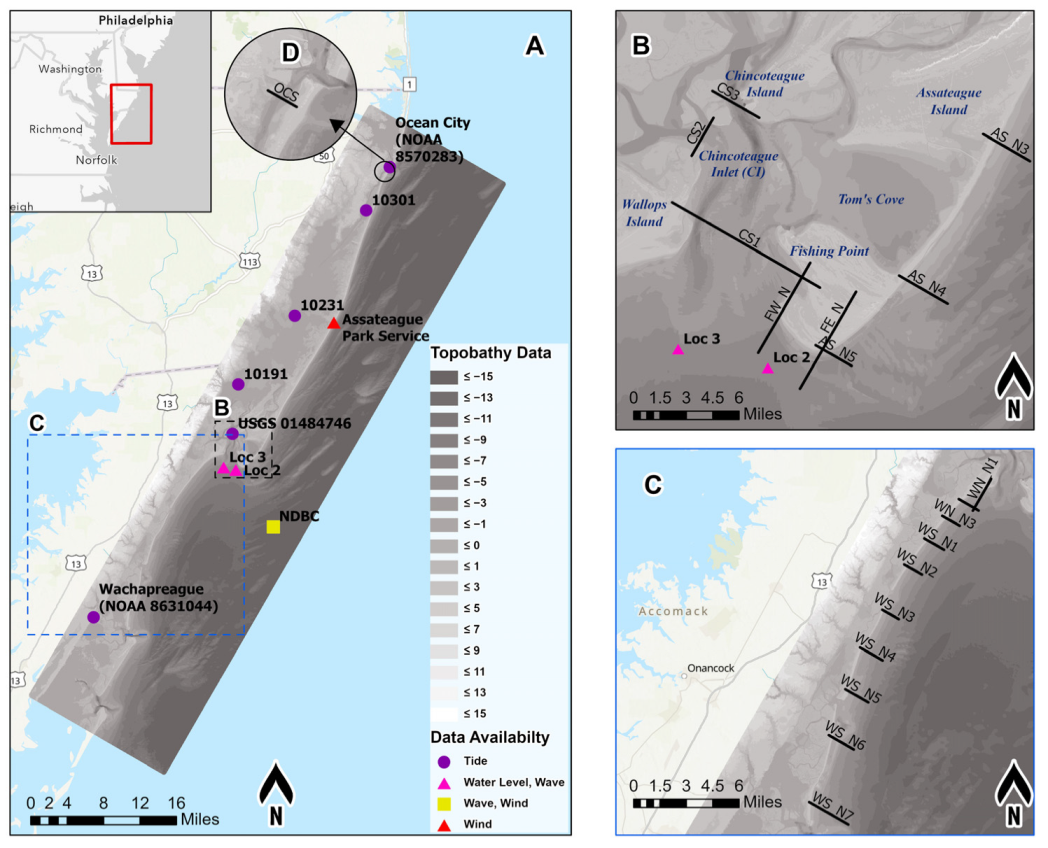
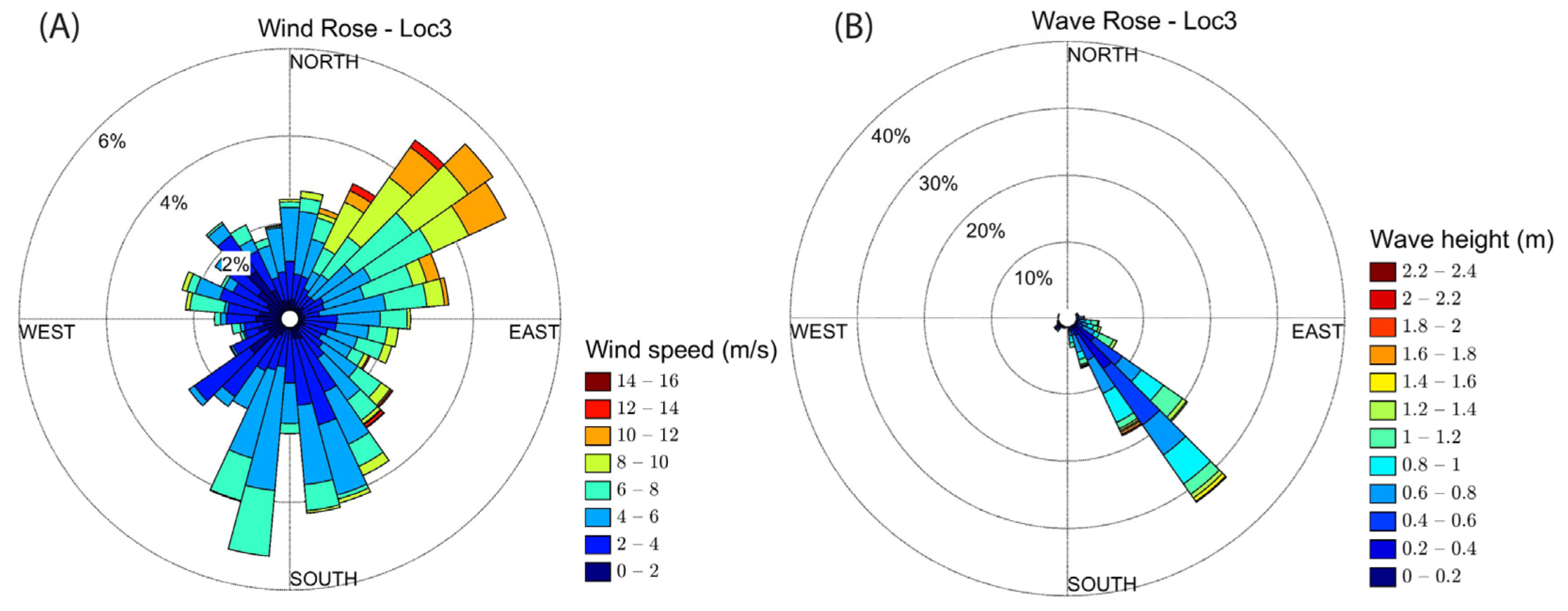
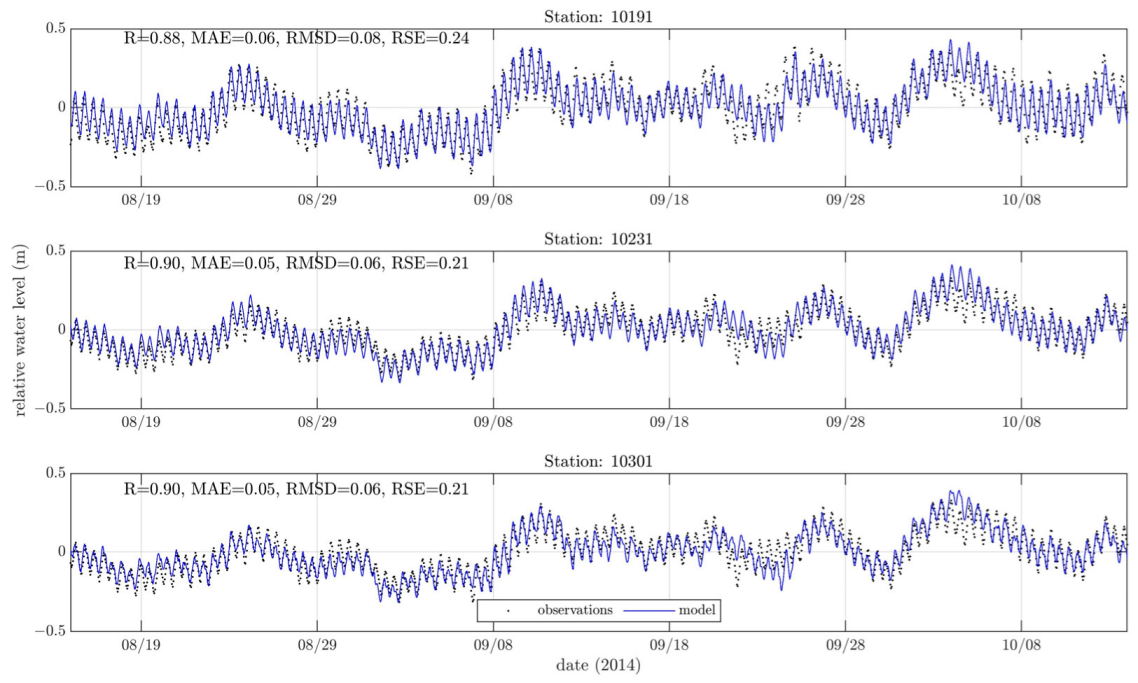

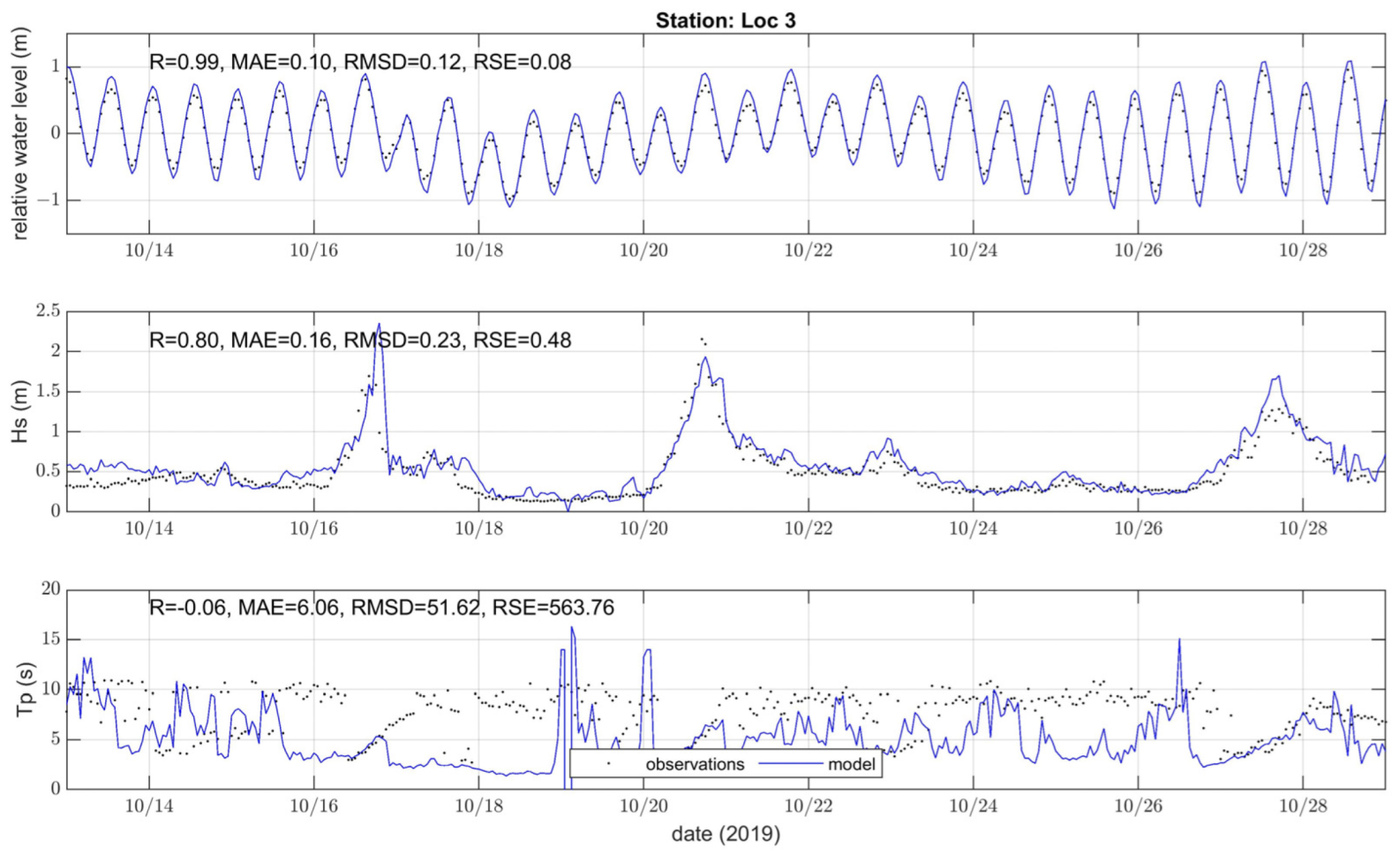
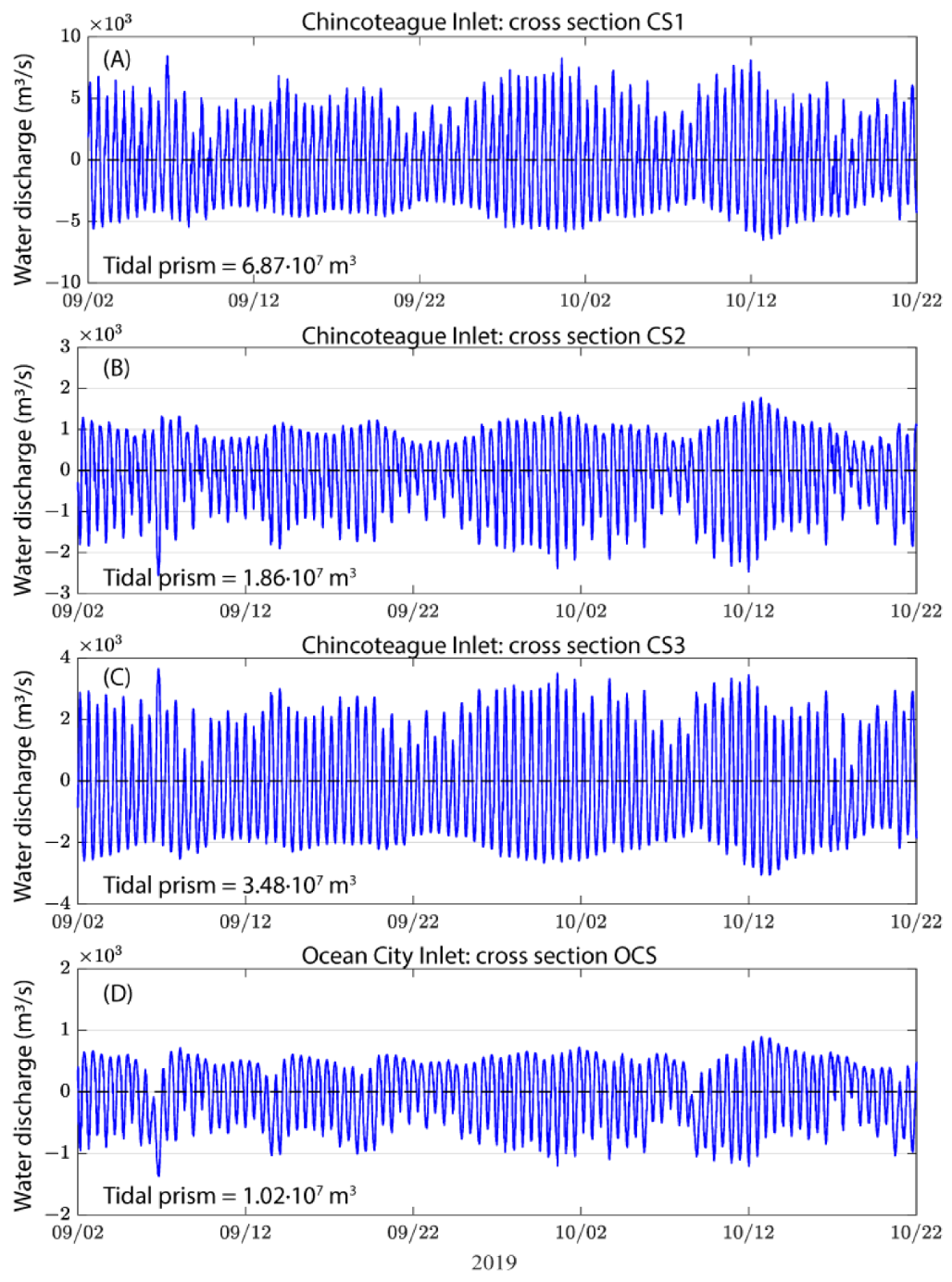

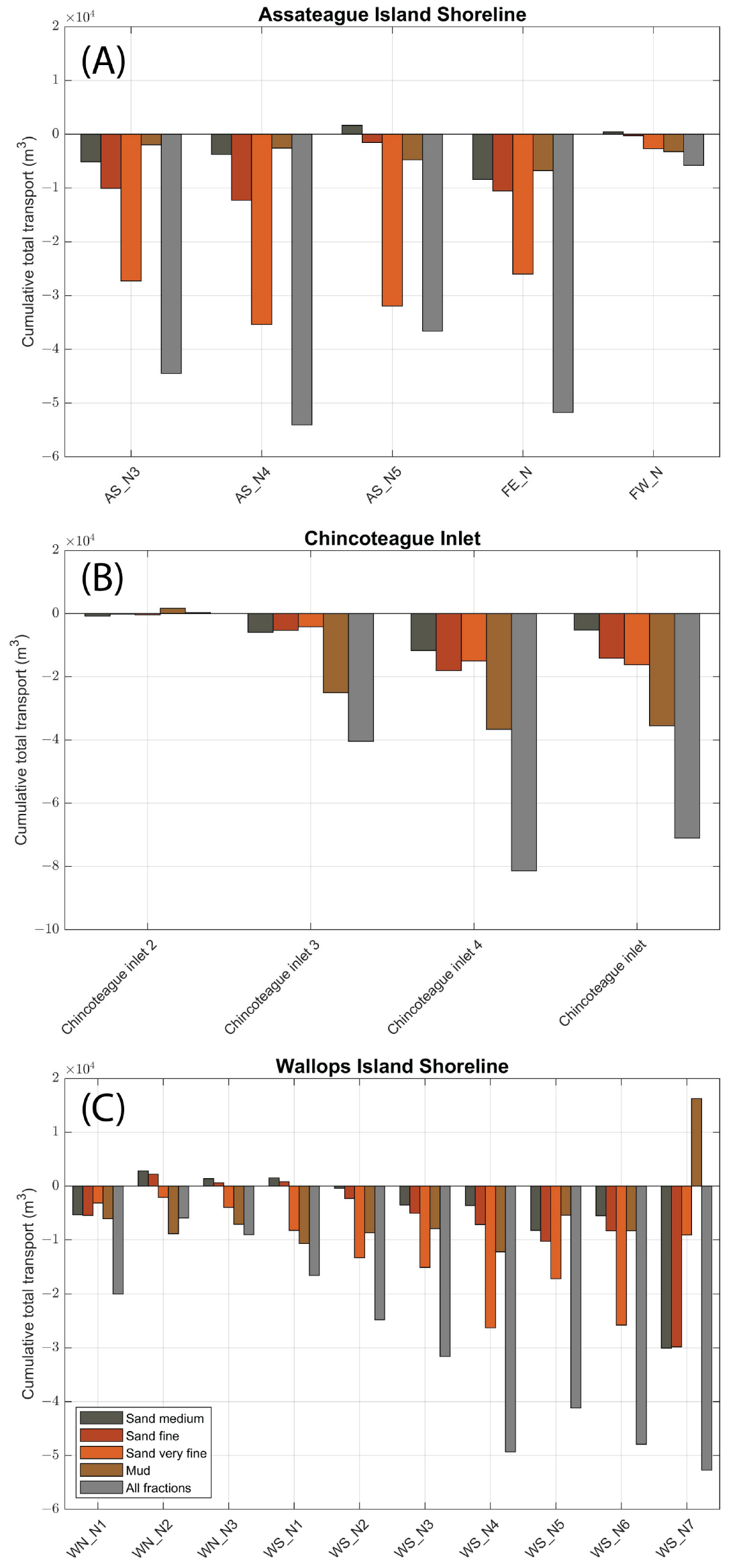
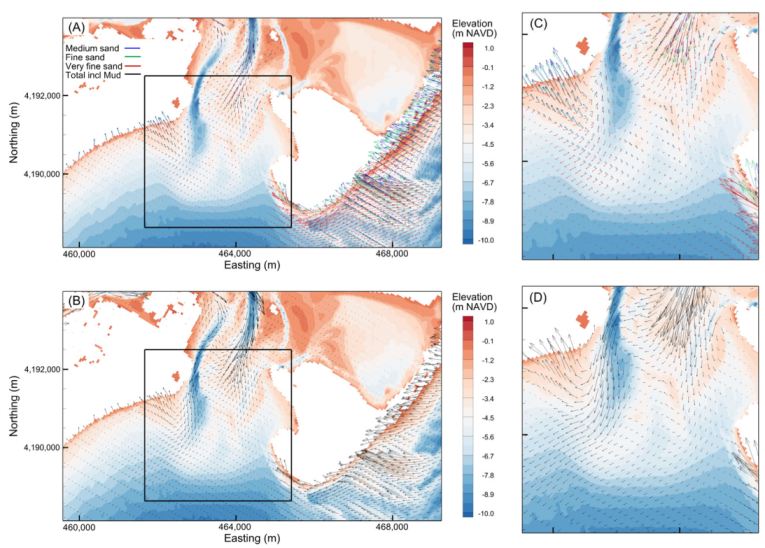
| Variable | Station/Location | R | MAE (m) | RMSD (m) | RSE |
|---|---|---|---|---|---|
| Water surface elevation | 10191 | 0.88 | 0.06 | 0.08 | 0.24 |
| 10231 | 0.90 | 0.05 | 0.06 | 0.21 | |
| 10301 | 0.90 | 0.05 | 0.06 | 0.21 | |
| Loc 2 | 0.95 | 0.14 | 0.18 | 0.17 | |
| Loc 3 | 0.99 | 0.10 | 0.12 | 0.08 | |
| Significant wave height | Loc 2 | 0.69 | 0.29 | 0.34 | 1.99 |
| Loc 3 | 0.80 | 0.16 | 0.23 | 0.48 |
| Cross-Section Location | Background Tidal (m3/s) | Hurricane Dorian (m3/s) | Nor’easters (m3/s) | |||
|---|---|---|---|---|---|---|
| Flood | Ebb | Flood Surge | Ebb Surge | Flood Surge | Ebb Surge | |
| CS1 | 0.8–0.11 | 0.04–0.07 | 0.17 | 0.27 | 0.22–0.34 | 0.34–0.70 |
| CS2 | 0.02–0.04 | 0.02–0.04 | 0.13 | 0.08 | 0.05–0.15 | 0.15–0.26 |
| CS3 | 0.025–0.06 | 0.05–0.075 | 0.17 | 0.15 | 0.07–0.21 | 0.10–0.15 |
Disclaimer/Publisher’s Note: The statements, opinions and data contained in all publications are solely those of the individual author(s) and contributor(s) and not of MDPI and/or the editor(s). MDPI and/or the editor(s) disclaim responsibility for any injury to people or property resulting from any ideas, methods, instructions or products referred to in the content. |
© 2023 by the authors. Licensee MDPI, Basel, Switzerland. This article is an open access article distributed under the terms and conditions of the Creative Commons Attribution (CC BY) license (https://creativecommons.org/licenses/by/4.0/).
Share and Cite
Georgiou, I.Y.; Messina, F.; Sakib, M.M.; Zou, S.; Foster-Martinez, M.; Bregman, M.; Hein, C.J.; Fenster, M.S.; Shawler, J.L.; McPherran, K.; et al. Hydrodynamics and Sediment-Transport Pathways along a Mixed-Energy Spit-Inlet System: A Modeling Study at Chincoteague Inlet (Virginia, USA). J. Mar. Sci. Eng. 2023, 11, 1075. https://doi.org/10.3390/jmse11051075
Georgiou IY, Messina F, Sakib MM, Zou S, Foster-Martinez M, Bregman M, Hein CJ, Fenster MS, Shawler JL, McPherran K, et al. Hydrodynamics and Sediment-Transport Pathways along a Mixed-Energy Spit-Inlet System: A Modeling Study at Chincoteague Inlet (Virginia, USA). Journal of Marine Science and Engineering. 2023; 11(5):1075. https://doi.org/10.3390/jmse11051075
Chicago/Turabian StyleGeorgiou, Ioannis Y., Francesca Messina, Md Mohiuddin Sakib, Shan Zou, Madeline Foster-Martinez, Martijn Bregman, Christopher J. Hein, Michael S. Fenster, Justin L. Shawler, Kaitlyn McPherran, and et al. 2023. "Hydrodynamics and Sediment-Transport Pathways along a Mixed-Energy Spit-Inlet System: A Modeling Study at Chincoteague Inlet (Virginia, USA)" Journal of Marine Science and Engineering 11, no. 5: 1075. https://doi.org/10.3390/jmse11051075
APA StyleGeorgiou, I. Y., Messina, F., Sakib, M. M., Zou, S., Foster-Martinez, M., Bregman, M., Hein, C. J., Fenster, M. S., Shawler, J. L., McPherran, K., & Trembanis, A. C. (2023). Hydrodynamics and Sediment-Transport Pathways along a Mixed-Energy Spit-Inlet System: A Modeling Study at Chincoteague Inlet (Virginia, USA). Journal of Marine Science and Engineering, 11(5), 1075. https://doi.org/10.3390/jmse11051075







